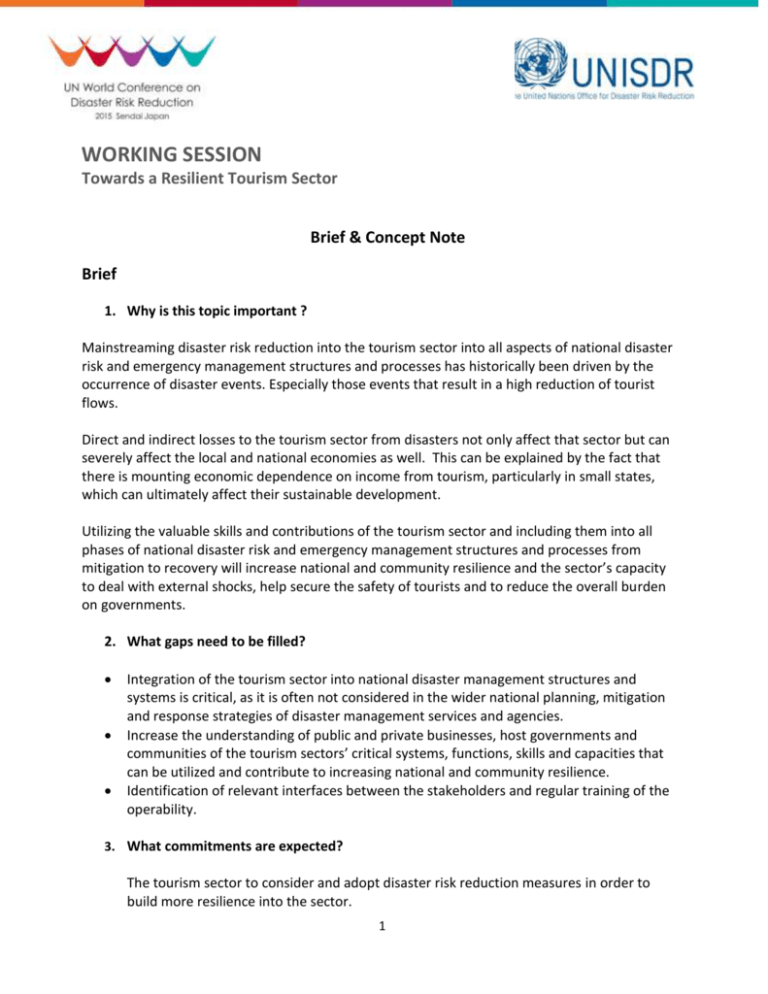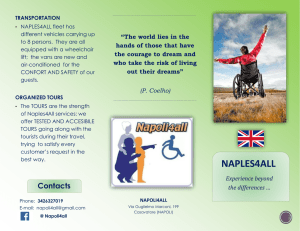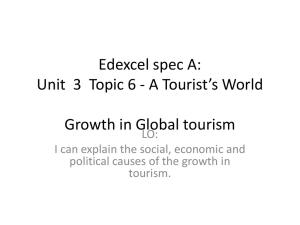Towards a Resilient Tourism Sector
advertisement

WORKING SESSION Towards a Resilient Tourism Sector Brief & Concept Note Brief 1. Why is this topic important ? Mainstreaming disaster risk reduction into the tourism sector into all aspects of national disaster risk and emergency management structures and processes has historically been driven by the occurrence of disaster events. Especially those events that result in a high reduction of tourist flows. Direct and indirect losses to the tourism sector from disasters not only affect that sector but can severely affect the local and national economies as well. This can be explained by the fact that there is mounting economic dependence on income from tourism, particularly in small states, which can ultimately affect their sustainable development. Utilizing the valuable skills and contributions of the tourism sector and including them into all phases of national disaster risk and emergency management structures and processes from mitigation to recovery will increase national and community resilience and the sector’s capacity to deal with external shocks, help secure the safety of tourists and to reduce the overall burden on governments. 2. What gaps need to be filled? Integration of the tourism sector into national disaster management structures and systems is critical, as it is often not considered in the wider national planning, mitigation and response strategies of disaster management services and agencies. Increase the understanding of public and private businesses, host governments and communities of the tourism sectors’ critical systems, functions, skills and capacities that can be utilized and contribute to increasing national and community resilience. Identification of relevant interfaces between the stakeholders and regular training of the operability. 3. What commitments are expected? The tourism sector to consider and adopt disaster risk reduction measures in order to build more resilience into the sector. 1 Concept Note Schedule Monday 16 March 2015, 12:00-13:30 Room and Venue Hagi Hall, Sendai International Conference Centre Organizing Team UNWTO, GIZ/GIDRM, JTM, PATA and UNISDR UNISDR Focal Point Timothy Wilcox (wilcoxt@un.org) Background and Rationale Though the tourism sector at an aggregated global level is resilient and constantly growing, at a destination level it is highly volatile economic activity. Therefore any direct or indirect dependency needs to take these specific circumstances carefully in account to allow for a resilient and sustainable development at the local and national level. Accelerating resilience within the sector means a re-alignment and integration of tourism systems within the national and local disaster risk and emergency management sector. It further requires the responsibility of increasing this resilience to be shared amongst all relevant stakeholders. Being aware of the needs to do this, partners can attend to, their capacity and capabilities and their ability to draw on external sources to establish partnerships with other stakeholders who share responsibility to mitigate the impacts of hazards and disasters. The tourism sector is mostly made up of small and medium enterprises therefore its resilience relies on a complex set of networks. Due to the nature of its infrastructure and attractions which are at the same time in higher risk areas such as beach and coastal fronts, river valleys, mountain regions and remote islands. An actual or perceived disaster event can interrupt tourism demand for a significant duration of time. These SMEs will often be locally owned and operated with little understanding or application of business continuity management practices to help them through crises. Tourism products are also predominantly immaterial and often depend on perceptions, as a result, the nature of the tourism sector markets, services and operations make it more susceptible to crises. In many smaller developing countries, the tourism sector often plays a significant part in the national income of that nation. With the frequency and intensity of annual climate related hazards it is imperative that this sector is resilient and contributes to sustainable economic development as disasters can seriously 2 undermine sustainable development gains and put private and public investments at risk. A resilient tourism sector, its resources, technical skill and potential contributions, are currently a neglected asset in the disaster risk and emergency management sector. Due to a consistent lack of dialogue and understanding between the two sectors, it is critical that effective coordination, information sharing and communication is strengthened between them in order for critical functions to be prepared before a crisis and also able to better absorb, restore and recover from crises. Furthermore, working with the tourism sector to increase their resiliency and reduce the risk of damage and loss they face from annual natural hazards such as drought, flood, cyclones, hurricanes and earthquakes will increase their ability to maintain business continuity, reduce financial loss and ultimately contribute to sustain economic and development growth of the local and national economy. Session Objectives The objectives of the session include; Discuss how the tourism sector is collaborating with the sectors responsible for disasters to mitigate risks, plan, respond and recover from disaster events; Discuss the challenges of integrating the tourism sector into local, national and regional disaster risk and emergency management systems; Explore existing activities in the tourism sector to build their resilience and reduce risk from hazards and disaster events. Enhance our understanding of why a resilient tourism sector will strengthen the resilience of other sectors of societies and help contribute to the sustainable economic growth of developing countries; Draw from the discussion critical recommendations that can enhance the resilience of the tourism sector, by using the tourism sector’s capacities to mitigate risks from hazards and prepare and respond to disasters. Discussion agenda and structure 1. Opening remarks (5mns) 2. Keynote address (10mns) 3. Panel discussion (60mns) a. Global and regional dimension of integration between disaster risk management and tourism b. Strategy and Practice between the public and private sectors of tourism and disaster risk management 3 c. Future directions 4. Open discussion (10mns) 5. Closing (5mns) Expected outcomes This session is expected to outline key objectives to accelerate the mainstreaming of disaster risk reduction in the tourism sector as well as the integration of the tourism sector into disaster risk and emergency management structures. It will gather opinions regarding what needs to be done over the next 10 years, to ensure that not only a resilient tourism sector is strengthened but overall national resilience is increased to mitigate risks, and to plan for, respond to, and recover from disasters. Commitment / special announcement in support of a post2015 framework for DRR To be confirmed Expected number of participants 200 Background documents World Tourism Organization (forthcoming) Tourism and Emergency Management, UNWTO. Madrid UNWTO Resilience Planning for the Tourism Sector (forthcoming paper) UNWTO (2011) Recommendations on the Use of Georeferences, Date and Time in Travel Advice and Event Information. UNWTO (2011) Toolbox for Crisis Communication in Tourism. UNWTO (2006) Tourist safety and Security. Practical Measures for Destinations. UNISDR (2013) Global Assessment Report on Disaster Risk Reduction Samoa and GEF - Resilience of Tourism-reliant Communities to Climate Change Risks project (2014) PATA, GIZ/GIDRM & UNISDR - Hotel Resilient – Strengthening Resilience in the Tourism Sector (2014) S.A.M.O.A. Pathway (2014) Outcome Statement of the 3rd Small Island Developing States Global Conference – Apia, Samoa 4







